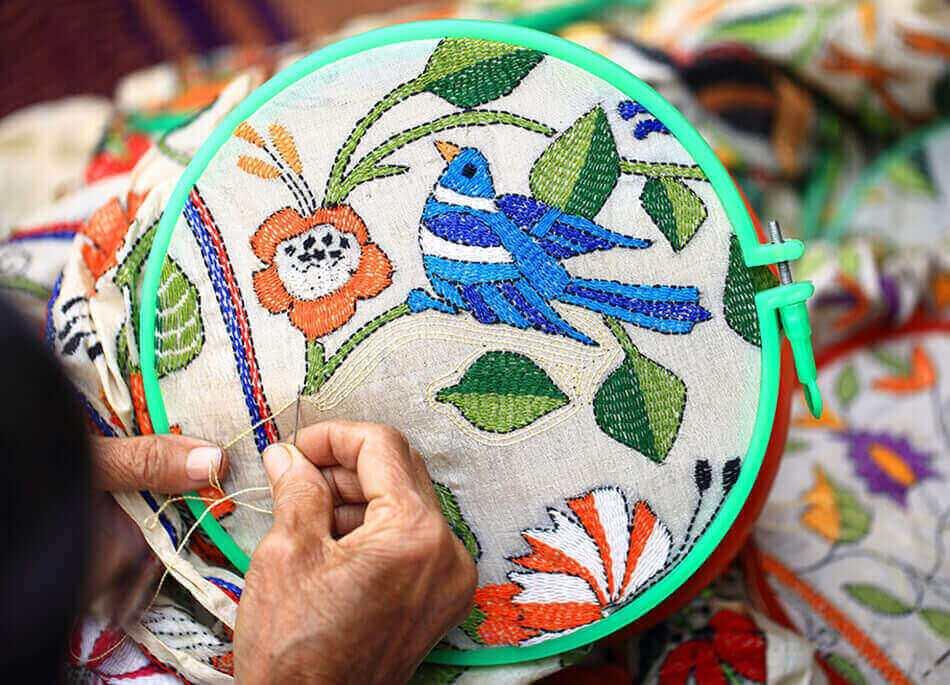Embroidery is an ancient craft deeply ingrained in India’s cultural heritage and it dates back thousands of years. From intricately embroidered textiles to religious and cultural artifacts, this art form has played an important role in shaping the history of ancient Indian civilization. Ancient Indian embroidery encompassed a large variety of techniques and materials, each reflecting the craftsmanship of different religions and communities, and a unique history and style.
-
-
Zardosi
-
Zardosi is a very intricate and time-consuming technique, where gold or silver thread is used to embroider. This embroidery was used on rich fabrics like velvet and silk to be used for royals in ancient times. It is considered to be a luxurious form of embroidery which is why it is often used for ceremonial garments like bridal lehengas. Zardosi embroidery is practiced across various regions of India; one of these is the older quarters of Delhi.
-
Chikankari
Chikankari is characterized by its delicate and lacy patterns and is used on fine muslin fabrics. It originally started with white thread on white fabric but now can be found in a variety of colors. It was first introduced in Lucknow, Uttar Pradesh, and is still considered as a very popular embroidery style in India.
-
Kantha
Kantha is a style of embroidery used on old sarees or suits. It originates from West Bengal and is also known as dorukha because it looks similar from both front and back. It is recognized for its simple and elegant designs.
-
Phulkari
Phulkari originated from the state of Punjab. It is characterized by the colorful flower motifs embroidered using multi-colored threads. Khaddar was the traditional fabric used for this type of embroidery, but today it is seen on many types of fabrics like cotton and chiffon.
- Shisha
Shisha work was first introduced in India by Iranian travelers. This embroidery is done by cross-stitching over various shapes of small mirrors. This style has many variations because it is performed across the states of Gujarat, Rajasthan, and Haryana.
In India, a variety of embroidery techniques are used, each resulting in intricate and elaborate designs. These methods involve different kinds of stitches including satin stitch, chain stitch, and running stitch, showcasing the unique creativity and craftsmanship of various regions.
Historical Traditions
Embroidery is said to be traced back to the Indus Valley civilization, with evidence of intricate threadwork found in archaeological remains. The oldest evidence of needlework in India traces back to this time, and it is believed that traders from Central Asia introduced the art to the region. Embroidery flourished in later periods of civilization, especially in the Mauryan and Gupta empires, where it was used to embellish royal clothing, religious clothing, and decorative artifacts. The Mughal Empire, which ruled India from the 16th to the 18th centuries, also had a significant impact on embroidery in India. The Mughals brought their techniques and designs, which were then combined with existing Indian styles to create new and distinct forms of embroidery.
Embroidery in ancient India was filled with profound symbolism and multiple interpretations, reflecting the spiritual, cultural, and social culture of the time. Each motif and pattern had meaning, which was often rooted in mythology and religion. For example, embroidering Gods and Goddesses signified devotion and reverence, while animals like elephants were embroidered to represent strength and wisdom. Symbols like the Lotus flower symbolized purity and spiritual enlightenment in Hinduism. Embroidery uses intricate designs and symbolic imagery as a non-verbal language to communicate beliefs, ideas, and cultural values across generations.
Social and Economic Impact
Embroidery played a crucial role in the economic and social situation of ancient India. Embroidery provided a source of income for countless artists, particularly women, who perfected their skills and workmanship over generations of practice. These skilled embroiderers worked in royal palaces, workshops, and houses, where their complex designs decorated clothing, textiles, and ceremonial artifacts. The economic significance of embroidery expanded beyond individual artists, creating strong trade networks and commercial contacts within India and with other countries. Textiles embroidered in India were highly sought after by traders and merchants, fetching high prices in foreign marketplaces and fueling economic growth in regions known for their embroidery traditions.
During the British Raj, the traditional craft of embroidery faced major challenges due to the influx of factory-produced clothing from colonial countries. The introduction of textile mills posed an immediate threat to the livelihoods of skilled artisans who had perfected their craft for generations. With the introduction of cheaper, mass-produced fabrics, demand for handcrafted embroidered clothes declined, resulting in a loss of popularity and economic difficulties for many artisans. With the introduction of cheaper, mass-produced fabrics, demand for handcrafted embroidered clothes fell, resulting in a loss of patronage and economic difficulties for many craftspeople. Despite these challenges, embroidery has survived as a part of India’s cultural heritage, thanks to dedicated artists and communities that continue to practice their trade even amidst turbulent times.
In conclusion, embroidery holds a unique place in ancient India’s culture, representing artistic expression, cultural identity, and craftsmanship. Embroidery has played a significant part in molding the visual landscape of Indian society, dating back to ancient civilizations and continuing into the present day. As we continue to preserve and protect this rich tradition, we recognize embroidery’s ongoing legacy in ancient India and celebrate its beauty, creativity, and cultural significance.























